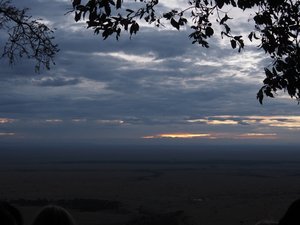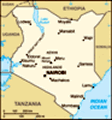Advertisement

 Dawn over the Maasai Mara
Dawn over the Maasai Mara
Subtle colour gradually spreads.Unusually for me, I voluntarily got up at 5:30, but since I went to bed at 9:30, it wasn’t too bad. My tent has only a few faint lights that have forced me to use my flashlight to find things. After each full day, I undo the day, arrange for the next day, and find bed welcome.
This morning the attraction was watching the sun rise above the escarpment on the other side of the Mara River valley. At 6:10 my backpack was ready for the day, and I walked to the designated sunrise viewing location. A group of Swedish students were there already. I took some pictures from the edge of the group, until the chaperone generously pointed out a chair free at the front. I immediately took advantage.
The Maasai Mara spread wide far below in the dark. Streaks of early light shone through the clouds. Pink decorated the far edges of the clouds. Through a stack of clouds at the centre, yellow slowly glowed brighter and brighter. In a moment, the ball of the sun moved quickly into the layered clouds. Pale light soon bought the day to the deep valley.
With the others, I

 Mara Conservancy
Mara Conservancy
Essential instructionhurried off to breakfast, as our departure was at 7:00.
Payment and passports were required at the entrance to the
Maasai Mara National Reserve , handled by Lucas. We were entering the Mara Triangle, that is, the land south of the Mara River bordered by the escarpment and by the border with Tanzania. The other part of the valley is called the Greater Mara.
Even before we arrived, we saw giraffe, and in quick succession zebras, impalas and elephants. At the gate we saw monkeys. My list of animals seen during the day occupies three pages of my little notebook. My predominant sensation is wonder at seeing what are exotic animals to us wandering around in proliferation and co-existing in combinations that are astonishing to me. For instance, zebras and wildebeest (or White Bearded Gnu) travel together in large mixed herds, because zebras eat the tops of taller grass and wildebeest eat lower grass, made shorter by the zebras. Also, zebras have keener eyesight, and wildebeest have a better sense of smell. Together they provide safety in numbers.
For most species in the Mara, babies are born at any time during the year. Whenever we stopped to look at zebras,

 Terrapin
Terrapin
Dusty camouflagewildebeest, Cape buffalo, baboons, elephants, Eland, impala, or giraffes, we always saw babies and juveniles of various ages with their mothers. The offspring may seek mothering from several adult females, but fathers often avoid family groupings. A number of species have bachelor groups of young males, chased out of the herd by their fathers; this has the effect of eliminating in-breeding. For example, it is better that male elephants don’t breed until 25 years, although they get the urge at 16 years.
We saw tiny animals, too. The funniest encounter was with a terrapin, about four inches across and covered in camouflaging road dust. I just happened to notice it as I was looking out the window, and Albert stopped. It was crossing the road – very dangerous. We were cheering it on when another vehicle came along, intent on passing us. Frantically, we gestured for it to stop, which it did within a foot of the terrapin. Once the others could see it, we urged it to get across the road (as if it could hear or understand us). Instead, it used its flippers to pile more road dust onto its back, turned around and headed for what
it thought was the shade under our truck. Albert inched forward to get away, but it just adjusted its trajectory. Finally, the truck was far enough away that the terrapin kept going all the way into the grass, on the same side where it had started. Albert said that they usually live in pairs and considered this was a young one that was lost. Much later, at a hippo pool, we saw two adult terrapin, which were about a foot across.
A lot of hippos lived in the hippo pool in this section of the Mara River, along with a lot of crocodiles. The crocodiles mainly did nothing, sunning themselves on the edges of the river or on one long sandbar. The hippos did nothing except come up for air, huffing in big breaths when they surfaced. Nevertheless, their inaction was fascinating. This was the place where the great migrations happen, as seen on TV. The migration takes place from about June until September. Now, only the stragglers were left, and they will probably stay in the Mara Triangle until next year. Apparently, some wildebeest/zebra herds get confused by rain, if it falls while they are migrating, and they
stop.
In movie trivia, Albert pointed out where some of
Out of Africa had been filmed. The actual place where Denys Finch Hatton was buried, near the Karen Blixen Museum, was now too populated to be a wilderness, and the action came to the Maasai Mara instead. During the month they filmed, Albert’s truck was Meryl Streep’s dressing room; she stayed the whole time in a basic tent with all the crew. Every day his truck was loaded with her costumes, and she came in to change. Robert Redford flew in daily from Nairobi.
To my delight, I was introduced to the local croton plant. It looks nothing like the crotons in my house, nor in Costa Rica. It was a bush with small leaves, with highlights of pink amongst the green. Lovely plant!
Since the animals have no fear of our trucks, funny things happen. A family of Spotted Hyenas was resting on the edge of the road, except for the young male. He was snoozing right on the road. The approach of our vehicles did not disturb his nap, although the other family members stirred about slightly. As we slowly drove by, exclaiming and chattering, he

 Spotted Hyena, young male
Spotted Hyena, young male
Completely unconcerned, minimally interestedmomentarily raised his head to look around, not particularly at us. Unalarmed, he returned to snoozing.
[youtube=
]
[youtube=
]
[youtube=
]
Advertisement
Tot: 0.048s; Tpl: 0.012s; cc: 8; qc: 22; dbt: 0.0161s; 1; m:domysql w:travelblog (10.17.0.13); sld: 1;
; mem: 1.1mb
























Isabel Gibson
non-member comment
Great videos and photos! The former are strong technically as well as evocative of the pace of the viewing, if you see what I mean. I particularly like the photo of the giraffe's head sticking out above the tree, the buffalo skeleton, and the numerous birds that I've never seen (or even heard tell of). Fascinating to see the speciation in herons, for example, in different parts of the world. Any idea what bird is hiding in the croton?